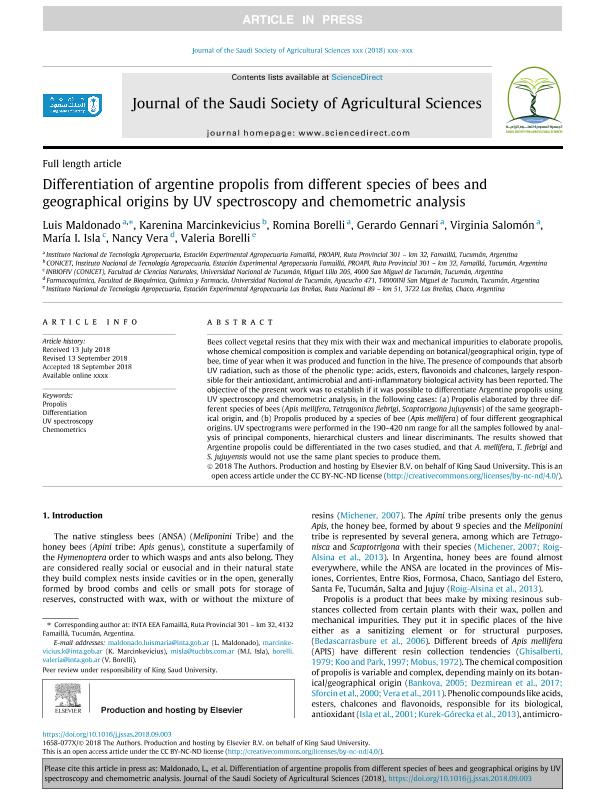Artículo
Differentiation of argentine propolis from different species of bees and geographical origins by UV spectroscopy and chemometric analysis
Maldonado, Luis María; Marcinkevicius, Karenina ; Borelli, Romina; Gennari, Gerardo; Salomón, Virginia; Isla, Maria Ines
; Borelli, Romina; Gennari, Gerardo; Salomón, Virginia; Isla, Maria Ines ; Vera, Nancy; Borelli, Valeria Soledad
; Vera, Nancy; Borelli, Valeria Soledad
 ; Borelli, Romina; Gennari, Gerardo; Salomón, Virginia; Isla, Maria Ines
; Borelli, Romina; Gennari, Gerardo; Salomón, Virginia; Isla, Maria Ines ; Vera, Nancy; Borelli, Valeria Soledad
; Vera, Nancy; Borelli, Valeria Soledad
Fecha de publicación:
09/2018
Editorial:
ELSEVIER
Revista:
Journal of the Saudi Society of Agricultural Sciences
ISSN:
1658-077X
Idioma:
Inglés
Tipo de recurso:
Artículo publicado
Clasificación temática:
Resumen
Bees collect vegetal resins that they mix with their wax and mechanical impurities to elaborate propolis, whose chemical composition is complex and variable depending on botanical/geographical origin, type of bee, time of year when it was produced and function in the hive. The presence of compounds that absorb UV radiation, such as those of the phenolic type: acids, esters, flavonoids and chalcones, largely responsible for their antioxidant, antimicrobial and anti-inflammatory biological activity has been reported. The objective of the present work was to establish if it was possible to differentiate Argentine propolis using UV spectroscopy and chemometric analysis, in the following cases: a) Propolis elaborated by three different species of bees (Apis mellifera, Tetragonisca fiebrigi, Scaptotrigona jujuyensis) of the same geographical origin, and b) Propolis produced by a species of bee (Apis mellifera) of four different geographical origins. UV spectrograms were performed in the 190 to 420 nm range for all the samples followed by analysis of principal components, hierarchical clusters and linear discriminants. The results showed that Argentine propolis could be differentiated in the two cases studied, and that A.mellifera, T, fiebrigi and S. jujuyensis would not use the same plant species to produce them.
Palabras clave:
Propolis
,
Differentiation
,
Uv Spectroscopy
,
Chemometrics
Archivos asociados
Licencia
Identificadores
Colecciones
Articulos(CCT - NOA SUR)
Articulos de CTRO.CIENTIFICO TECNOL.CONICET - NOA SUR
Articulos de CTRO.CIENTIFICO TECNOL.CONICET - NOA SUR
Citación
Maldonado, Luis María; Marcinkevicius, Karenina; Borelli, Romina; Gennari, Gerardo; Salomón, Virginia; et al.; Differentiation of argentine propolis from different species of bees and geographical origins by UV spectroscopy and chemometric analysis; ELSEVIER; Journal of the Saudi Society of Agricultural Sciences; 9-2018
Compartir
Altmétricas



